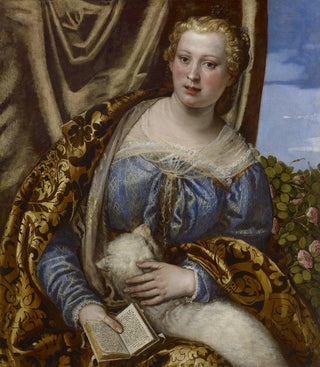Art print | Portrait of a lady as Saint Agnes - Paolo Véronèse


View from behind

Frame (optional)
Art print Portrait of a Lady as Saint Agnes - Paolo Véronèse – Captivating Introduction
In the rich and complex universe of Venetian Renaissance painting, the "Art print Portrait of a Lady as Saint Agnes" by Paolo Véronèse stands out for its beauty and intensity. This painting, which evokes both holiness and humanity, immerses us in a world where spirituality and aesthetics meet. The depiction of this female figure, draped in sumptuous fabrics and adorned with religious symbols, captivates the eye and invites contemplation. Véronèse, an undisputed master of colorism and light, succeeds in creating an atmosphere that is both serene and meaningful, making this work a true masterpiece of sacred art.
Style and uniqueness of the work
Véronèse's style is characterized by a masterful use of color and light, which give his works a nearly living dimension. In the "Art print Portrait of a Lady as Saint Agnes," the chosen palette evokes sublime softness, where warm tones blend harmoniously. The carefully rendered drapery gives an impression of movement and fluidity, while the lady's face, with its poignant expressiveness, seems to transcend time. The composition is carefully balanced, with each element placed within the whole, thus reinforcing the solemnity of the scene. The presence of attributes of Saint Agnes, such as the lamb, enhances the spiritual dimension of this portrait, while offering a rich and nuanced symbolic reading.
The artist and his influence
Paolo Véronèse, born in 1528 in Verona, is one of the most emblematic artists of the Italian Renaissance. His career, marked by numerous prestigious commissions, testifies to his immense talent and ability to captivate the elites of his time. Influenced by Titian and Tintoretto, Véronèse develops a personal style that combines the brilliance of colors with a dynamic composition, often populated with figures in motion. His approach to sacred painting, while deeply respectful of traditions, is distinguished by a humanist sensitivity that allows connecting the divine to the

Matte finish

View from behind

Frame (optional)
Art print Portrait of a Lady as Saint Agnes - Paolo Véronèse – Captivating Introduction
In the rich and complex universe of Venetian Renaissance painting, the "Art print Portrait of a Lady as Saint Agnes" by Paolo Véronèse stands out for its beauty and intensity. This painting, which evokes both holiness and humanity, immerses us in a world where spirituality and aesthetics meet. The depiction of this female figure, draped in sumptuous fabrics and adorned with religious symbols, captivates the eye and invites contemplation. Véronèse, an undisputed master of colorism and light, succeeds in creating an atmosphere that is both serene and meaningful, making this work a true masterpiece of sacred art.
Style and uniqueness of the work
Véronèse's style is characterized by a masterful use of color and light, which give his works a nearly living dimension. In the "Art print Portrait of a Lady as Saint Agnes," the chosen palette evokes sublime softness, where warm tones blend harmoniously. The carefully rendered drapery gives an impression of movement and fluidity, while the lady's face, with its poignant expressiveness, seems to transcend time. The composition is carefully balanced, with each element placed within the whole, thus reinforcing the solemnity of the scene. The presence of attributes of Saint Agnes, such as the lamb, enhances the spiritual dimension of this portrait, while offering a rich and nuanced symbolic reading.
The artist and his influence
Paolo Véronèse, born in 1528 in Verona, is one of the most emblematic artists of the Italian Renaissance. His career, marked by numerous prestigious commissions, testifies to his immense talent and ability to captivate the elites of his time. Influenced by Titian and Tintoretto, Véronèse develops a personal style that combines the brilliance of colors with a dynamic composition, often populated with figures in motion. His approach to sacred painting, while deeply respectful of traditions, is distinguished by a humanist sensitivity that allows connecting the divine to the






